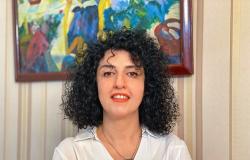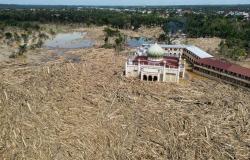Hello and welcome to the details of In Gaza, starving children fill hospital wards as famine looms and now with the details
Nevin Al Sukari - Sana'a - GAZA, March 19 — Six-year-old Fadi al-Zant is acutely malnourished, his ribs protruding under leathery skin, his eyes sunken as he lays in bed at the Kamal Adwan hospital in northern Gaza, where famine is bearing down.
Fadi’s spindly legs can no longer support him enough to walk.
Photographs of Fadi from before the war show a smiling, healthy-looking child, standing in blue denims next to his taller twin with his hair brushed. A short video clip shows him dancing at a wedding with a little girl.
Fadi suffers from cystic fibrosis. Before the conflict, he was taking medicine that his family can no longer find and eating a carefully balanced variety of food no longer available in the Palestinian enclave, according to his mother Shimaa al-Zant.
Advertisement
“His condition is getting worse. He is getting weaker. He keeps losing his ability to do things,” she said in a video obtained by Reuters from a freelancer. “He can no longer stand. When I help him stand up, he falls straight away.”
More than five months into Israel’s ground and air campaign, launched in response to Hamas’ October 7 attack, there are widespread shortages of food, medicines and clean water in Gaza, doctors and aid agencies say.
The Kamal Adwan hospital, caring for Fadi, had also treated most of the 27 children the health ministry in Hamas-run Gaza says have died of malnutrition and dehydration in recent weeks.
Advertisement
Others died in Gaza City’s al-Shifa Hospital, also in the north, the ministry said, and in the southernmost city of Rafah, where the UN relief agency says over 1 million Palestinians have sought refuge from Israel’s offensive.
Reuters saw 10 badly malnourished children during a visit last week to the al-Awda health centre in Rafah, arranged with nursing staff who gave the news agency unimpeded access to the ward. Reuters was not able to independently verify the deaths reported by the ministry.
Without urgent action, famine will hit between now and May in northern Gaza, where 300,000 people are trapped by fighting, the world’s hunger watchdog, the Integrated Food Security Phase Classification (IPC), said in a review on Monday.
The review’s most likely scenario said “extremely critical levels of acute malnutrition and mortality” were imminent for more than two thirds of the people in the north. The IPC is made up of UN agencies and global aid groups.
Israel’s Cogat, the military body that handles aid transfers to Gaza, did not specifically respond to Reuters questions about the deaths of children from hunger and dehydration. It said Israel put no limits on the amount of aid that can enter.
Following the IPC review, Israeli government spokesperson Eylon Levy posted on X that the number of food trucks had increased in March and that Israel was taking measures to bolster “delivery efforts” to the north.
“It’s a bad assessment, based on an out of date picture,” he said of the review.
The White House referred Reuters to comments from National Security advisor Jake Sullivan, who said responsibility to address impending famine “starts, first and foremost, with Israel.”
USAID chief Samantha Power said the IPC assessment marked “a horrific milestone” and called on Israel to open more land routes.
In response to a question from Reuters about the IPC report, senior Hamas official Sami Abu Zuhri said Israel’s Prime Minister Binyamin Netenyahu was “defying the world and pursuing the killing of the Palestinian people in Gaza by bombs and starvation.”
UN aid agencies have said “overwhelming obstacles” to moving aid to the north of Gaza will only be overcome with a ceasefire and the opening of border crossings closed by Israel after October 7.
Displaced
In better times, Fadi’s favourite food was chicken shawarma, a Levantine grill dish, his mother said, and he ate a lot of fruit and drank a lot of milk.
When the war began, she said, the family fled their home in al-Nasr district of Gaza City, which suffered widespread damage from bombardment. They were displaced four times before arriving in Beit Lahia, she added.
Fadi’s condition began to deteriorate about two months ago and he was admitted to Kamal Adwan hospital, Zant said. Creon - the medicine that people with cystic fibrosis need to supplement pancreatic enzymes that help digest food - was not available. Sometimes, Fadi had diarrhoea 10 times in one night.
Before the war, the child weighed 30kg (66 lb). Now he weighs just 12kg (26 lb), his mother said.
“He used to eat well. His treatment was available. His face was full. He was a child that did not seem ill. He went to kindergarten with his brother,” she said.
Cogat did not respond to a question about the availability of Creon, but said Israel had “not refused a single shipment of medical supplies.”
Reuters was not able to independently establish if any such shipments had been blocked, or verify with hospital officials the extent to which Creon supplies were disrupted.
The Gaza health ministry says lack of medication contributed to the deterioration of the conditions of the children who died.
As well as for children like Fadi who have pre-exisiting medical conditions, risks are rapidly rising for many others in Gaza, UN agencies say.
The UN children’s agency Unicef said on Friday that nearly 1 in 3 children under two years old in northern Gaza suffer from acute malnutrition, twice as many as in January.
In shelters and health centres visited by Unicef and its partners, 4.5 per cent of children had severe wasting, the most life-threatening form of malnutrition, it said.
“Unless fighting stops and aid agencies have full access throughout Gaza then hundreds if not thousands more children could die of hunger,” Unicef executive director Catherine Russell said on Tuesday in a joint statement with the World Food Programme.
If Israel goes ahead with a promised offensive in Rafah, 1.1 million people in Gaza, half the population, are expected to face an extreme lack of food, in which starvation and death are present in households, the IPC report said.
Last Thursday, Cogat’s Col. Elad Goren told reporters access to food was stable in the south and centre of the enclave.
Human Rights Watch said in late February that Israel was obstructing the provision of basic services as well as the entry and distribution of fuel and lifesaving aid in Gaza. It said this was “collective punishment,” considered a war crime under international humanitarian law.
Cogat told Reuters that Israel was making “extensive efforts to increase the amount of aid that enters Gaza,” above and beyond its obligations.
“Any claims otherwise, including claims regarding collective punishment, are baseless in both fact and law,” it said.
Rafah
At al-Awda health centre in Rafah, more than a dozen women sat or stood tending their malnourished children.
Most of the children in the ward already had medical problems before the war, their relatives said, though pictures that the parents of two of them showed Reuters showed them looking notably healthier than now.
On March 4, 12-year-old Yazan al-Kafarna, who had cerebral palsy, died in southern Gaza, days after Reuters took photographs that showed his severe emaciation.
The ward nurse, Amira Abu Juwaiyad, said the hospital was unable to get enough milk for babies and that 10-15 cases were coming in daily under “catastrophic” conditions. Abu Juwaiyad did not say how much milk was available prior to the war.
Umm Mesbah Heji sat cradling her five-year-old daughter Israa, who is quadriplegic and epileptic.
Israa’s medications are no longer available and she has lost a lot of weight. Before the war, Heji used to feed her eggs and milk for breakfast, liver for lunch and rice for dinner, she said. Sometimes, she gave her yoghurt and fruit.
“I know she’s hungry. The food she eats isn’t available,” she said, adding that every day “I die one hundred times” feeling sad for her daughter.
Diarrhoea
Disease is aggravating the dire lack of food. Dehydration from diarrhoea, which the World Health Organisation says is rampant in the mass tent cities where displaced people cram together without proper sewage or clean water, hastens malnutrition.
One effect of acute hunger is to reduce immunity against such gastric diseases.
The WHO said last month that 90 per cent of children under 5 in Gaza were affected by one or more infectious diseases with 70 per cent having had diarrhoea in the previous two weeks - a 23-fold increase over cases before the war.
Kerstin Hanson, a US doctor working on nutrition with international charity Medecins Sans Frontieres, described the physical onset of malnutrition and dehydration.
Children grow lethargic and less responsive. Their skin loses its puffiness so that if pushed out of shape it may stay in that position. The eyes get sunken. The body emaciates.
Even for children who were healthy before the conflict, sustained malnutrition can stunt physical and brain development.
As acute malnutrition takes hold, a child’s body stops growing, Hanson said. Then it shuts down everything except vital functions. “Your heart and lungs will keep functioning, but ... maybe there isn’t enough energy to keep your immune system functioning,” she said.
After that, the body would “kind of start eating itself”, using muscle, fat and anywhere else it could find energy to keep breathing and pumping blood. Eventually, it would just shut down.
Even when malnutrition does not reach that dangerous stage, its effects on development might be impossible to reverse if it is sustained, Hanson said. Children may never recover lost centimetres of growth. — Reuters
These were the details of the news In Gaza, starving children fill hospital wards as famine looms for this day. We hope that we have succeeded by giving you the full details and information. To follow all our news, you can subscribe to the alerts system or to one of our different systems to provide you with all that is new.
It is also worth noting that the original news has been published and is available at Malay Mail and the editorial team at AlKhaleej Today has confirmed it and it has been modified, and it may have been completely transferred or quoted from it and you can read and follow this news from its main source.




